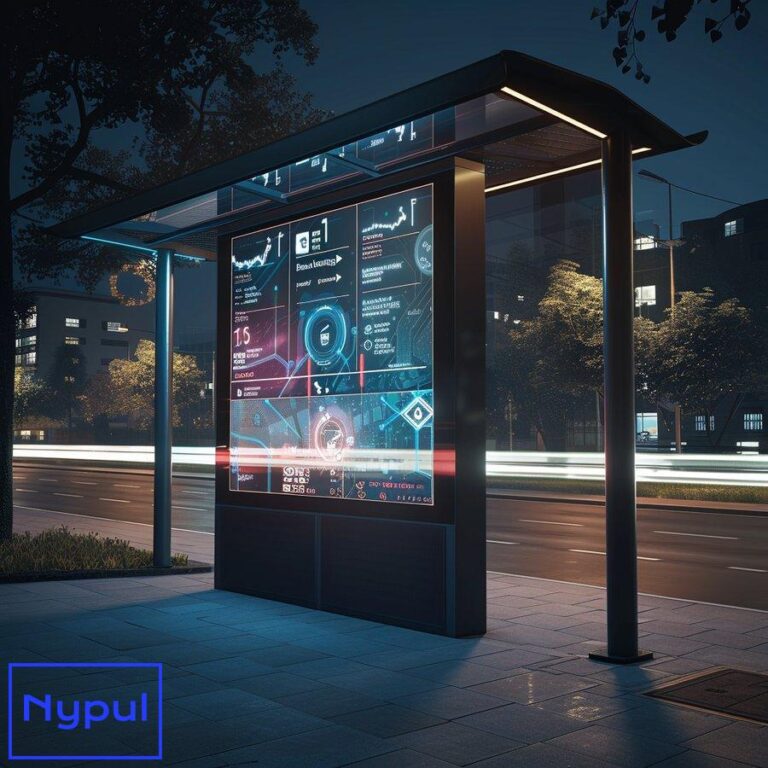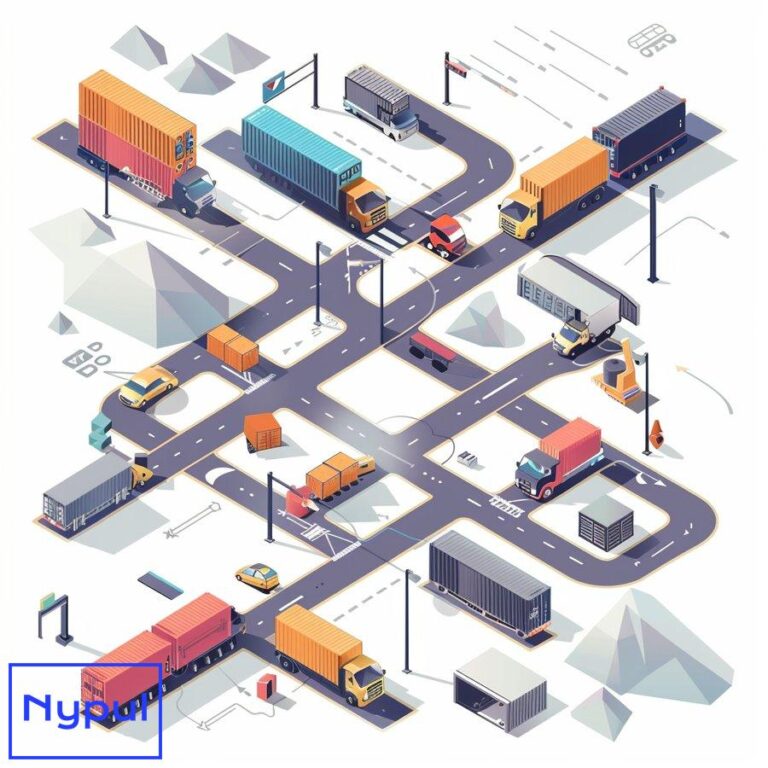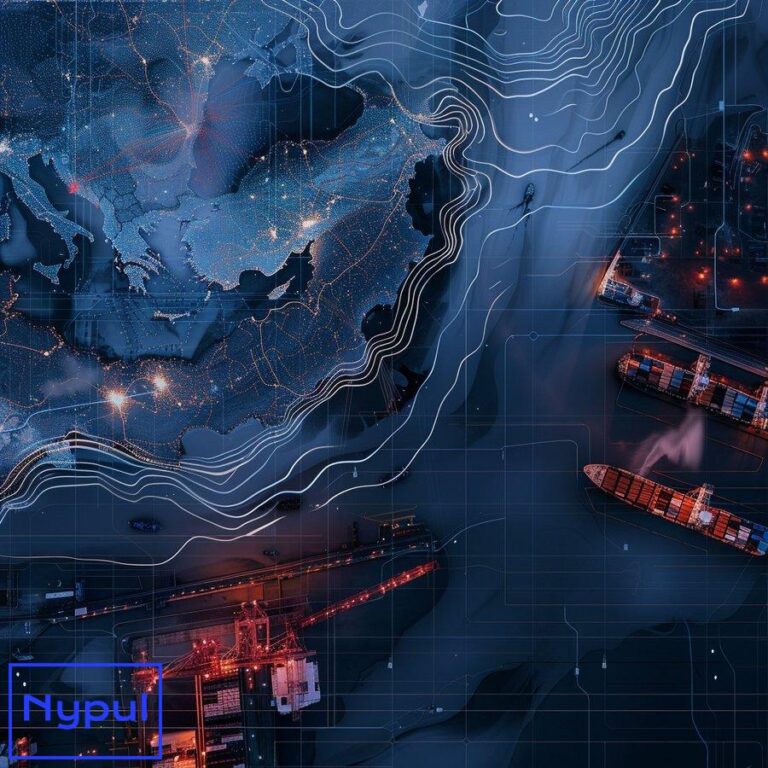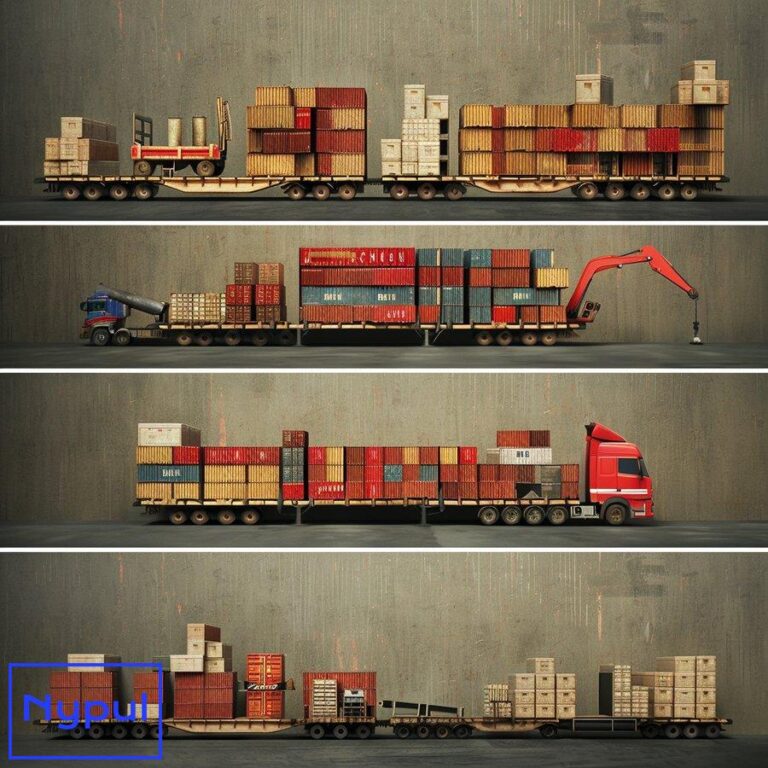What Are Digital Twins in Logistics
Digital twins in logistics represent virtual replicas of physical assets, processes, or systems within the supply chain and logistics industry. These digital counterparts simulate real-world operations, providing a dynamic, real-time view of logistics activities and enabling data-driven decision-making.
The concept of digital twins originated in the aerospace industry but has since found widespread application in various sectors, including logistics. In the context of logistics, digital twins serve as powerful tools for optimizing operations, predicting maintenance needs, and enhancing overall efficiency.
A digital twin in logistics typically consists of three main elements:
Physical Asset: This can be a warehouse, transportation vehicle, or even an entire supply chain network.
Virtual Model: A digital representation of the physical asset, created using 3D modeling, CAD software, or other advanced technologies.
Data Connection: Real-time data flows between the physical asset and its virtual counterpart, ensuring the digital twin accurately reflects the current state of the physical entity.
The implementation of digital twins in logistics involves a continuous cycle of data collection, analysis, and optimization. Sensors and IoT devices gather data from physical assets, which is then fed into the digital twin. Advanced analytics and machine learning algorithms process this data, generating insights and predictions that can be used to optimize operations in the real world.
To illustrate the concept of digital twins in logistics, consider the following table comparing traditional logistics management with digital twin-enabled logistics:
| Aspect | Traditional Logistics Management | Digital Twin-Enabled Logistics |
|---|---|---|
| Visibility | Limited real-time visibility | Comprehensive, real-time view of operations |
| Predictive Capabilities | Reactive approach to issues | Proactive problem-solving and predictive maintenance |
| Decision-Making | Based on historical data and experience | Data-driven decisions using real-time insights |
| Optimization | Manual process optimization | Continuous, automated optimization |
| Risk Management | Limited ability to simulate scenarios | Advanced scenario planning and risk assessment |
Digital twins in logistics offer numerous advantages over traditional management approaches. They provide unprecedented visibility into operations, enable proactive problem-solving, and facilitate data-driven decision-making. By creating a virtual environment for testing and optimization, digital twins allow logistics companies to improve efficiency, reduce costs, and enhance customer satisfaction without disrupting real-world operations.
The adoption of digital twins in logistics is driven by several factors:
Increasing Complexity: As supply chains become more global and intricate, digital twins offer a way to manage and optimize complex logistics networks effectively.
Technological Advancements: The rise of IoT, big data analytics, and cloud computing has made it feasible to create and maintain accurate digital representations of physical assets and processes.
Demand for Efficiency: In an increasingly competitive market, logistics companies are seeking ways to optimize operations and reduce costs, which digital twins can facilitate.
Customer Expectations: With growing demands for faster, more transparent, and more reliable logistics services, digital twins provide a means to meet these expectations through improved visibility and predictive capabilities.
As the logistics industry continues to evolve, digital twins are expected to play an increasingly crucial role in shaping the future of supply chain management. They offer a powerful tool for logistics companies to navigate the challenges of a rapidly changing business environment and stay ahead of the competition.
What are the Core Components of Digital Twins?
Digital twins in logistics comprise several core components that work together to create a comprehensive virtual representation of physical assets and processes. Understanding these components is crucial for effectively implementing and leveraging digital twin technology in logistics operations.
![]()
Physical Asset or Process
The foundation of any digital twin is the physical entity it represents. In logistics, this can include:
- Warehouses and distribution centers
- Transportation vehicles (trucks, ships, planes)
- Inventory management systems
- Supply chain networks
- Individual products or shipments
The physical asset or process serves as the source of data for the digital twin and is the ultimate beneficiary of insights generated by the virtual model.
Sensors and IoT Devices
These devices are responsible for collecting real-time data from the physical asset or process. They act as the bridge between the physical and digital worlds, continuously monitoring various parameters such as:
- Location and movement
- Temperature and humidity
- Fuel consumption
- Equipment performance
- Inventory levels
The quality and reliability of sensor data are crucial for the accuracy of the digital twin.
Data Integration Platform
This component aggregates and processes data from various sources, including:
- Sensor and IoT device data
- Historical operational data
- External data sources (e.g., weather, traffic, market conditions)
The data integration platform ensures that all relevant information is consolidated and standardized for use in the digital twin model.
3D Modeling and Visualization
Advanced 3D modeling techniques are used to create a visual representation of the physical asset or process. This component may include:
- CAD (Computer-Aided Design) models
- Virtual reality (VR) and augmented reality (AR) interfaces
- Interactive dashboards and user interfaces
The visual aspect of digital twins enhances understanding and facilitates intuitive interaction with the virtual model.
Simulation Engine
The simulation engine is the core of the digital twin, responsible for:
- Replicating the behavior of the physical asset or process
- Running “what-if” scenarios
- Predicting future states based on current data and historical trends
Advanced simulation engines may incorporate physics-based modeling and machine learning algorithms to enhance accuracy and predictive capabilities.
Analytics and AI
This component processes the data and simulation results to generate actionable insights. It may include:
- Predictive analytics for maintenance and demand forecasting
- Optimization algorithms for route planning and resource allocation
- Anomaly detection for identifying potential issues or inefficiencies
The analytics and AI component is crucial for transforming raw data into valuable business intelligence.
Cloud Infrastructure
Cloud computing provides the necessary computational power and storage capacity to support digital twins. Key aspects include:
- Scalability to handle large volumes of data
- Real-time processing capabilities
- Secure data storage and transmission
- Accessibility from multiple locations and devices
Cloud infrastructure enables the digital twin to operate efficiently and remain up-to-date in real-time.
User Interface and Collaboration Tools
These components allow users to interact with the digital twin and share insights across the organization. They may include:
- Customizable dashboards
- Reporting tools
- Collaboration platforms for team communication and decision-making
Effective user interfaces ensure that the insights generated by the digital twin are accessible and actionable for all relevant stakeholders.
Integration with Enterprise Systems
To maximize the value of digital twins, they must be integrated with existing enterprise systems such as:
- Enterprise Resource Planning (ERP) systems
- Warehouse Management Systems (WMS)
- Transportation Management Systems (TMS)
- Customer Relationship Management (CRM) systems
This integration ensures that insights from the digital twin can be seamlessly incorporated into broader business processes and decision-making.
The following table summarizes the core components of digital twins in logistics and their primary functions:
| Component | Primary Function |
|---|---|
| Physical Asset or Process | Serves as the real-world counterpart and data source |
| Sensors and IoT Devices | Collect real-time data from the physical entity |
| Data Integration Platform | Aggregates and standardizes data from various sources |
| 3D Modeling and Visualization | Creates visual representation of the physical entity |
| Simulation Engine | Replicates behavior and runs predictive scenarios |
| Analytics and AI | Generates insights and optimizes operations |
| Cloud Infrastructure | Provides computational power and storage |
| User Interface and Collaboration Tools | Facilitates interaction and information sharing |
| Integration with Enterprise Systems | Connects digital twin insights with broader business processes |
Each of these components plays a vital role in creating a comprehensive and effective digital twin for logistics applications. The seamless integration of these elements enables logistics companies to gain a holistic view of their operations, make data-driven decisions, and continuously optimize their processes.
As digital twin technology continues to evolve, we can expect these core components to become more sophisticated and interconnected. Future developments may include enhanced AI capabilities, more immersive visualization technologies, and even greater integration with emerging technologies such as blockchain and edge computing.
How do Technologies Enable Digital Twins?
![]()
Digital twins in logistics are made possible by a convergence of advanced technologies that work together to create accurate, real-time virtual representations of physical assets and processes. These enabling technologies form the backbone of digital twin implementations, allowing for sophisticated modeling, data analysis, and predictive capabilities.
Internet of Things (IoT)
IoT technology serves as the primary data collection mechanism for digital twins in logistics. It enables:
- Real-time data gathering from physical assets
- Continuous monitoring of operational parameters
- Seamless communication between devices and systems
IoT devices such as GPS trackers, temperature sensors, and RFID tags provide the constant stream of data necessary to keep digital twins up-to-date and accurate.
Big Data Analytics
The vast amounts of data generated by IoT devices and other sources require powerful analytics capabilities:
- Processing and analyzing large volumes of structured and unstructured data
- Identifying patterns and trends in operational data
- Generating actionable insights from complex datasets
Big data analytics platforms enable digital twins to make sense of the enormous amount of information flowing through logistics systems.
Artificial Intelligence (AI) and Machine Learning (ML)
AI and ML technologies enhance the predictive and optimization capabilities of digital twins:
- Developing predictive models for maintenance and demand forecasting
- Optimizing routes and resource allocation in real-time
- Identifying anomalies and potential issues before they occur
These technologies allow digital twins to not only replicate current conditions but also anticipate future states and recommend optimal actions.
Cloud Computing
Cloud platforms provide the necessary infrastructure for digital twins:
- Scalable computing power to handle complex simulations
- Secure storage for vast amounts of data
- Accessibility from multiple locations and devices
Cloud computing enables digital twins to operate efficiently and remain synchronized across global logistics networks.
5G Networks
The latest generation of cellular network technology supports digital twins by:
- Enabling faster data transmission speeds
- Reducing latency for real-time updates
- Supporting a higher density of connected devices
5G networks enhance the responsiveness and accuracy of digital twins, particularly for mobile assets like vehicles and shipments.
Blockchain
While not always a core component, blockchain technology can enhance digital twins in logistics by:
- Ensuring data integrity and traceability
- Facilitating secure and transparent information sharing across supply chains
- Enabling smart contracts for automated logistics processes
Blockchain integration can improve trust and collaboration in digital twin implementations, especially in complex supply chain scenarios.
Advanced Visualization Technologies
Technologies such as Virtual Reality (VR) and Augmented Reality (AR) enhance the user experience of digital twins:
- Creating immersive 3D visualizations of logistics operations
- Enabling interactive simulations for training and planning
- Facilitating remote monitoring and management of physical assets
These visualization technologies make digital twins more intuitive and accessible for users across the organization.
Edge Computing
Edge computing complements cloud infrastructure by:
- Processing data closer to the source for faster response times
- Reducing bandwidth requirements for data transmission
- Enabling offline or low-connectivity operation of digital twins
This technology is particularly valuable for digital twins of mobile assets or operations in remote locations.
Digital Thread
The digital thread concept ties together various technologies to create a comprehensive digital record:
- Linking data across the entire lifecycle of a product or process
- Enabling end-to-end traceability in supply chains
- Facilitating continuous improvement through data-driven insights
The digital thread enhances the value of digital twins by providing a holistic view of logistics operations.
Simulation Software
Advanced simulation software is crucial for creating accurate digital representations:
- Modeling complex physical systems and processes
- Running “what-if” scenarios to test different strategies
- Predicting outcomes based on various input parameters
Simulation software forms the core of many digital twin implementations, allowing for sophisticated analysis and optimization.
The following table illustrates how these technologies contribute to different aspects of digital twin functionality in logistics:
| Technology | Primary Contribution to Digital Twins |
|---|---|
| IoT | Real-time data collection and monitoring |
| Big Data Analytics | Processing and analyzing large datasets |
| AI and ML | Predictive modeling and optimization |
| Cloud Computing | Scalable infrastructure and accessibility |
| 5G Networks | Fast, low-latency data transmission |
| Blockchain | Data integrity and supply chain transparency |
| Advanced Visualization | Immersive user interfaces and simulations |
| Edge Computing | Local data processing and reduced latency |
| Digital Thread | End-to-end data linkage and traceability |
| Simulation Software | Accurate modeling and scenario testing |
The synergy between these technologies enables the creation of sophisticated digital twins that can accurately represent and optimize complex logistics operations. As these technologies continue to evolve and mature, we can expect digital twins to become even more powerful and integral to logistics management.
Future developments in these enabling technologies will likely lead to:
Enhanced Predictive Capabilities: More sophisticated AI and ML algorithms will improve the accuracy of forecasts and optimizations.
Greater Automation: Increased integration of digital twins with robotic systems and autonomous vehicles will enable more automated logistics operations.
Improved Real-Time Decision Making: Advances in edge computing and 5G networks will allow for faster processing and response times in digital twin applications.
More Comprehensive Digital Representations: As sensor technology improves and becomes more ubiquitous, digital twins will be able to capture and represent an even wider range of physical attributes and processes.
Increased Interoperability: Standardization efforts and improved integration technologies will allow digital twins from different systems and vendors to work together more seamlessly.
The continued advancement of these enabling technologies will drive the evolution of digital twins in logistics, leading to more efficient, resilient, and sustainable supply chain operations.
What are the Key Applications of Digital Twins in Logistics?
Digital twins have found numerous applications in the logistics industry, revolutionizing how companies manage their operations, assets, and supply chains. These virtual replicas offer unprecedented visibility, predictive capabilities, and optimization opportunities across various aspects of logistics. Let’s explore the key applications of digital twins in this sector.
Warehouse Management
![]()
Digital twins are transforming warehouse operations by creating virtual representations of physical warehouse spaces. This application enables:
- Optimal layout design and space utilization
- Real-time inventory tracking and management
- Automated picking and packing processes
- Predictive maintenance for warehouse equipment
By simulating different scenarios, warehouse managers can optimize storage arrangements, workflow patterns, and resource allocation, leading to increased efficiency and reduced operational costs.
Fleet Management and Vehicle Tracking
Digital twins of transportation fleets provide logistics companies with a comprehensive view of their vehicles’ status and performance. Key features include:
- Real-time tracking of vehicle location and condition
- Predictive maintenance scheduling
- Fuel consumption optimization
- Route optimization based on real-time traffic and weather data
These capabilities enable more efficient fleet utilization, reduced downtime, and improved delivery performance.
Supply Chain Visibility and Optimization
Digital twins of entire supply chain networks offer end-to-end visibility and optimization opportunities:
- Real-time tracking of goods throughout the supply chain
- Identification of bottlenecks and inefficiencies
- Scenario planning for supply chain disruptions
- Optimization of inventory levels across multiple locations
This holistic view allows companies to make informed decisions, mitigate risks, and improve overall supply chain resilience.
Last-Mile Delivery Optimization
Digital twins can model and optimize the complex last-mile delivery process:
- Dynamic route planning based on real-time conditions
- Optimization of delivery vehicle loading
- Prediction of delivery times and potential delays
- Simulation of different delivery strategies (e.g., hub-and-spoke vs. direct delivery)
These applications help logistics companies improve delivery efficiency, reduce costs, and enhance customer satisfaction.
Port and Terminal Operations
Digital twins of ports and terminals facilitate more efficient management of these critical logistics hubs:
- Optimization of container stacking and movement
- Coordination of vessel arrivals and departures
- Predictive maintenance of port equipment
- Simulation of different operational scenarios to improve throughput
By modeling these complex environments, digital twins help port operators maximize capacity utilization and minimize turnaround times.
Cold Chain Management
For temperature-sensitive goods, digital twins enable precise monitoring and control of the cold chain:
- Real-time temperature and humidity tracking
- Predictive maintenance of refrigeration equipment
- Optimization of storage and transportation conditions
- Simulation of different scenarios to ensure product integrity
These applications help reduce spoilage, ensure compliance with regulations, and maintain product quality throughout the logistics process.
Asset Performance Management
Digital twins of individual logistics assets (e.g., forklifts, conveyor systems, packaging machines) provide detailed insights into their performance and maintenance needs:
- Real-time monitoring of asset health and performance
- Predictive maintenance scheduling
- Optimization of asset utilization and energy consumption
- Simulation of different operational parameters to maximize efficiency
This application helps logistics companies extend asset lifespans, reduce downtime, and optimize operational efficiency.
Risk Management and Scenario Planning
Digital twins enable sophisticated risk assessment and scenario planning in logistics:
- Simulation of various disruption scenarios (e.g., natural disasters, geopolitical events)
- Assessment of the impact of changes in demand or supply
- Evaluation of different mitigation strategies
- Real-time risk monitoring and early warning systems
These capabilities help logistics companies build more resilient operations and respond more effectively to unexpected events.
Customer Experience Enhancement
Digital twins can be used to improve customer experience in logistics:
- Providing real-time tracking and status updates to customers
- Enabling more accurate delivery time predictions
- Facilitating person## What Benefits Do Digital Twins Offer to Logistics Operations?
Digital twins in logistics offer a wide range of benefits that can significantly improve operational efficiency, reduce costs, and enhance customer satisfaction. By providing real-time visibility, predictive capabilities, and optimization opportunities, digital twins enable logistics companies to make more informed decisions and adapt to changing market conditions more effectively.
Improved Operational Efficiency
Digital twins help optimize logistics operations by:
- Identifying and eliminating bottlenecks and inefficiencies
- Enabling just-in-time inventory management
- Optimizing resource allocation and utilization
- Reducing manual intervention and human error
These improvements lead to faster order fulfillment, reduced operational costs, and increased productivity.
Enhanced Asset Performance
Digital twins provide detailed insights into the performance and health of logistics assets, enabling:
- Predictive maintenance to reduce downtime and extend asset lifespan
- Optimization of asset utilization and energy consumption
- Improved decision-making regarding asset replacement or upgrades
By keeping assets running at peak performance, digital twins help logistics companies maximize their return on investment.
Improved Supply Chain Resilience
Digital twins offer a comprehensive view of the entire supply chain, allowing companies to:
- Identify and mitigate risks more effectively
- Respond quickly to disruptions and changes in demand or supply
- Simulate different scenarios to test the resilience of the supply chain
- Optimize inventory levels and distribution across multiple locations
These capabilities help logistics companies build more agile and resilient supply chains that can withstand unexpected challenges.
Reduced Operational Costs
By optimizing operations, improving asset performance, and enhancing supply chain resilience, digital twins help logistics companies reduce various costs, including:
- Labor costs through automation and improved efficiency
- Maintenance costs through predictive maintenance
- Inventory carrying costs through optimized inventory levels
- Transportation costs through route optimization and reduced delays
These cost savings can have a significant impact on a company’s bottom line and competitive positioning.
Enhanced Customer Experience
Digital twins enable logistics companies to provide better service to their customers by:
- Offering real-time tracking and status updates
- Providing more accurate delivery time estimates
- Reducing the frequency and impact of delivery delays
- Enabling personalized and flexible delivery options
By improving the customer experience, logistics companies can build stronger relationships with their clients and increase customer loyalty.
Improved Sustainability
Digital twins can contribute to more sustainable logistics operations by:
- Optimizing energy consumption and reducing emissions
- Enabling better waste management and recycling
- Facilitating the use of alternative fuels and renewable energy sources
- Improving the efficiency of reverse logistics and product returns
These sustainability benefits not only help logistics companies reduce their environmental impact but also align with growing customer and regulatory demands for more sustainable business practices.
The following table summarizes the key benefits of digital twins in logistics and their potential impact:
| Benefit | Impact |
|---|---|
| Improved Operational Efficiency | Faster order fulfillment, reduced costs, increased productivity |
| Enhanced Asset Performance | Reduced downtime, extended asset lifespan, optimized utilization |
| Improved Supply Chain Resilience | Faster response to disruptions, optimized inventory levels, enhanced agility |
| Reduced Operational Costs | Lower labor, maintenance, inventory carrying, and transportation costs |
| Enhanced Customer Experience | Improved customer satisfaction, increased loyalty, better service |
| Improved Sustainability | Reduced environmental impact, alignment with sustainability goals |
As digital twin technology continues to evolve and become more widely adopted, we can expect these benefits to become even more pronounced. The ability to create accurate virtual representations of complex logistics systems and processes will enable companies to make more informed decisions, optimize their operations, and stay ahead of the competition in an increasingly challenging market environment.
What Challenges Are Associated with Implementing Digital Twins?
While digital twins offer numerous benefits to logistics operations, implementing this technology also presents several challenges that companies must address to ensure successful deployment and long-term success. Understanding these challenges is crucial for developing effective strategies and overcoming potential roadblocks.
Data Integration and Quality

One of the primary challenges in implementing digital twins is ensuring seamless integration of data from various sources and maintaining data quality. Logistics operations often involve multiple systems, devices, and stakeholders, each generating and using data in different formats. Integrating these disparate data sources and ensuring data accuracy, consistency, and timeliness is crucial for creating reliable digital twins.
Sensor Deployment and Maintenance
Effective digital twin implementation relies on a network of sensors and IoT devices to collect real-time data from physical assets and processes. Deploying and maintaining these sensors can be challenging, especially in harsh or remote environments common in logistics operations. Issues such as sensor failure, battery life, and connectivity can impact data quality and lead to inaccuracies in the digital twin.
Computational Power and Storage Requirements
Digital twins require significant computational power and storage capacity to process large volumes of data, run complex simulations, and maintain accurate virtual representations. As logistics operations become more complex and data-intensive, the demands on computing resources will continue to grow. Ensuring that the necessary infrastructure is in place to support digital twin applications is crucial for their success.
Cybersecurity and Data Privacy Concerns
The increasing reliance on digital technologies in logistics operations raises concerns about cybersecurity and data privacy. Digital twins, by their nature, involve the collection and storage of sensitive data related to assets, operations, and customers. Protecting this data from cyber threats and ensuring compliance with data privacy regulations is essential for maintaining trust and mitigating legal and reputational risks.
Organizational Change Management
Implementing digital twins often requires significant changes to existing processes, workflows, and organizational structures. Resistance to change, lack of buy-in from stakeholders, and insufficient training can hinder the successful adoption of digital twin technology. Effective change management strategies, including clear communication, stakeholder engagement, and employee training, are necessary to overcome these challenges and ensure the successful integration of digital twins into the organization.
Talent and Skill Gaps
The implementation and maintenance of digital twins require specialized skills and expertise in areas such as data science, machine learning, simulation modeling, and IoT. However, there is a shortage of professionals with these skills in the logistics industry. Bridging this talent gap through training, hiring, and collaboration with external partners is crucial for successful digital twin implementation.
Scalability and Interoperability
As digital twin deployments grow in scale and complexity, ensuring their scalability and interoperability becomes a significant challenge. Digital twins must be able to adapt to changing business requirements, accommodate new data sources and technologies, and integrate seamlessly with existing systems. Developing scalable and interoperable digital twin architectures is essential for long-term success and flexibility.
Return on Investment (ROI) Justification
Implementing digital twins requires significant investments in technology, infrastructure, and talent. Justifying these investments and demonstrating the ROI can be challenging, especially in the short term. Logistics companies must develop robust business cases, identify key performance indicators, and track the benefits of digital twin implementation over time to ensure that the investment aligns with strategic objectives and delivers tangible results.
To overcome these challenges, logistics companies must adopt a comprehensive and strategic approach to digital twin implementation. This includes:
- Developing a clear vision and roadmap for digital twin adoption
- Investing in data management capabilities and infrastructure
- Implementing robust cybersecurity and data privacy measures
- Engaging in effective change management and stakeholder communication
- Investing in talent development and collaboration with external partners
- Adopting a modular and scalable approach to digital twin architecture
- Continuously monitoring and measuring the benefits of digital twin implementation
By addressing these challenges and adopting a proactive approach to digital twin implementation, logistics companies can unlock the full potential of this transformative technology and gain a competitive advantage in an increasingly complex and dynamic market environment.






